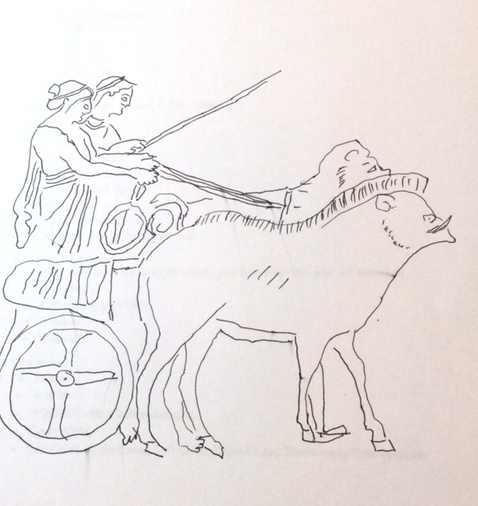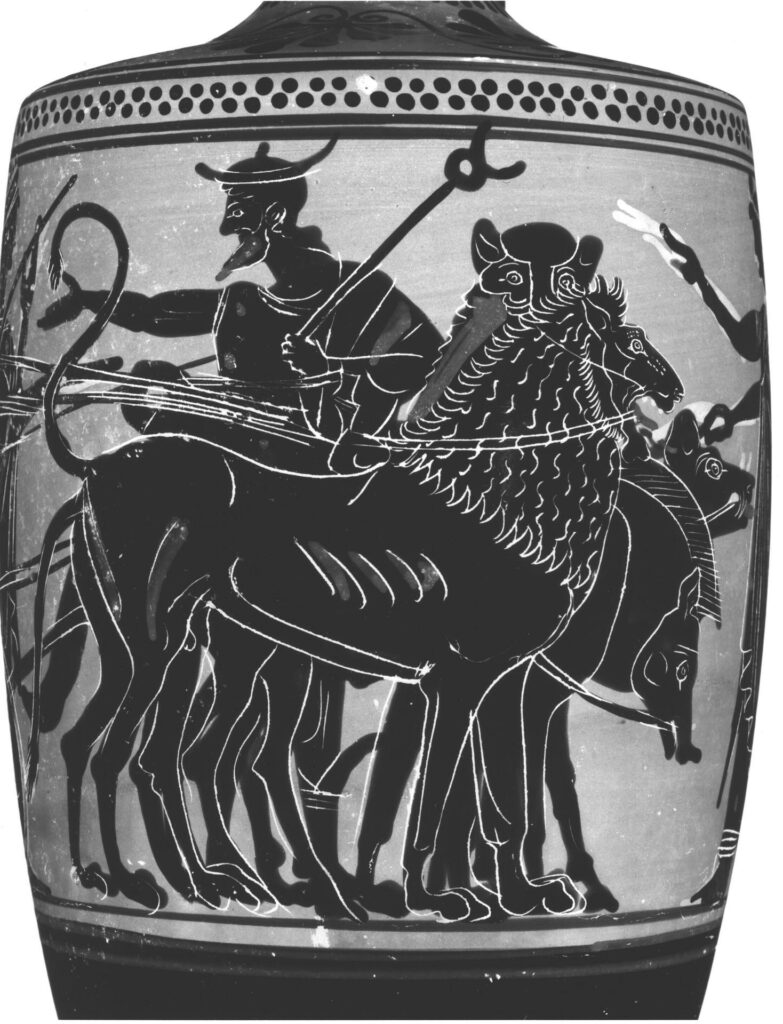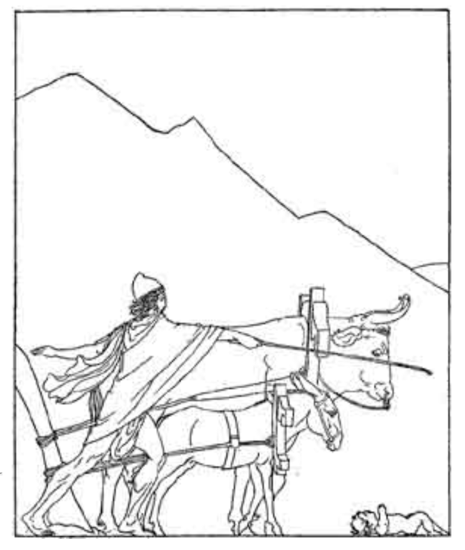And now she is back with the old dilemma – who caused the war? She has been blamed, Paris has been blamed but, fundamentally, it was the fault of Thetis, mother of Achilles. There is the old argument regarding Mésalliance, a goddess marries a mortal, some social discord is sure to arise[1]
Some social disruption! The destruction of Troy, the wasting of a generation of men on both sides of the Aegean Sea, and the civil strife, invasions and the Bronze Age collapse that followed is hardly “some social discord.”
Mésalliance from the French is “A marriage with a person of inferior social position.”[2]
A similar expression in English is “unequally-yoked”. It is based on 2 Corinthians 6:14 (King James): “Be ye not unequally yoked together with unbelievers.” Alternatively, it may be based on “Thou shalt not plow with an ox and an ass together.” from Deuteronomy 22:10 (King James)
The figure of speech is applied to marriage primarily and partnership in general. The image it projects is two different animals. When animals were unequally yoked, it meant they were not equal in strength or size, making the task difficult and the progress uneven.
There are four times in Ancient Greek literature and images where different animals are yoked together. I leave to the reader to decide how much mésalliance has to do with the story.
Cadmus and Harmonia

There is an amphora in the Louvre[3] depicting Cadmus and Harmonia in a chariot drawn by a lion and a boar, with Apollo playing his lyre. Generally, this is thought to be the bridal chariot of Cadmus and Harmonia. I can find no literary source explaining the scene. Some have suggested the painter (or inscriber) confused Cadmus and Admetus.[4]
Certainly this is a case of mésalliance of the newlyweds. Cadmus is mortal and Harmonia the daughter of Ares and Aphrodite. To find proof of the social discord that’s sure to arise, look at their grandson Dionysus’ return to Thebes, and their grandson Pentheus being torn apart (and possibly eaten) by his mother and aunts.[5] Nonnus wrote the Dionysiaca describing the battles between Dionysus and the more conservative element of Olympus.
Alcestis and Admetus

There is a lekythos with Apollo mounting a chariot drawn by lions, wolf and boar, accompanied by Hermes and two women.[6]
Angry because Apollo shot the Cyclops, Zeus would have cast him into Tartarus. However, thanks to his mother Leto, Zeus ordered him to serve a man for a year. So he went to Admetus, son of Pheres.[7]
When great numbers of suitors were seeking Alcestis, daughter of Pelias, in marriage, and Pelias was refusing many of them, he set a contest for them, promising that he would give her to the one who yoked wild beasts to a chariot. And so Admetus begged Apollo to help him. Apollo, since he had been kindly treated when given in servitude to him, provided him with a wild boar and lion yoked together, and with these he bore off Alcestis in marriage.[8]
Mésalliance was symbolized by their bridal chariot, and social discord appears late in their lives. Alcestis is threatened with an early death but is quickly rescued by Heracles.[9]
Odysseus and Telemachus

Odysseus had an unequally-yoked team.[10]
“He had earlier received an oracle warning him that if he went to Troy , he would return home after twenty years, alone, destitute, and having lost all his men. And so when he found out that an embassy was on its way to him, he pretended to be crazy by putting on a felt hat and yoking a horse and a bull together to a plow. When Palamedes saw him, he sensed that he was faking it, so he took Ulysses’ (Odysseus’) son Telemachus from the cradle put him in front of the plow, and said, “Put aside your trickery and join the others bound by (the Oath of Tyndareus). Then Ulysses (Odysseus) promised he would go.” [11]
The scene has the required mésalliance, followed by the social disruption! The destruction of Troy, the wasting of a generation of men on both sides of the Aegean Sea, civil strife, invasions and the Bronze Age collapse. Which was caused by the Oath of Tyndareus, which was Odysseus’ idea.
Polynices and Tydeus
The king of Argos was Adrastus, son of Talaus; and Polynices went up to his palace by night and engaged in a fight with Tydeus, son of Oeneus, who had fled from Calydon. At the sudden outcry Adrastus appeared and parted them, and remembering the words of a certain seer who told him to yoke his daughters in marriage to a boar and a lion,[12] he accepted them both as bridegrooms, because they had on their shields, one the forepart of a boar, and the other the forepart of a lion.[13]
And so began the War of the Seven Against Thebes started by Adrastus and his new sons-in-law. The marriages were certainly symbolic of mésalliance. And the subsequent social discord was massive; most of the seven warriors recruited against Thebes along with a lot of Thebans died, and their sons the Epigoni destroyed the city.[14]
Conclusion
Alcestis and Admetus’ bridal chariot might be unequally-yoked with mismatched animals, and mésalliance between bride and groom occurred late in life.
Cadmus and Harmonia are mismatched, the daughter of two Olympians and a foreigner. But social discord generated by their union may be reflected in the ongoing antagonism between their divine descendant Dionysus and Olympus.
Odysseus’ team was mismatched and maybe he was the cause of the Trojan War.
Finally, as to the Polynices and Tydeus pairing, all I can think is that it sparked the Theban Wars.
Afterwards
While contemplating Hyginus Fabulae 1.75 and wondering why Thersites does not appear there as a son of Agrius, my thoughts wandered to his cousin Diomedes. Famously, he is called the son of Tydeus by Homer. Then I was struck by a quote Walter Burkert[15] “The beds of the immortals are not barren—every act has issue.” The marriages discussed above mostly did not include gods. They were just mortal couples, with the possible exception of Harmonia. However they often resulted in the birth of gods.
The marriages of Polynices and Tydeus resulted in Diomedes whom Athena made an immortal god.[16] The marriage of Cadmus and Harmonia produced a host of gods.[17] The marriage of Penelope and Odysseus produced Telemachus, immortal spouse of Circe.[18] The marriage of Admetus and Alcestis does not fit the immortal children pattern, but produce “social discord.”
Notes
1 page 111, H.D. Helen in Egypt, Grove Press Inc. New York, 1961
2 The American Heritage® Dictionary of the English Language, 5th Edition
3 Louvre Vase Number 361412 (Numéro d’entrée : CA 1961 ; Numéro catalogue : F 384 bis)
https://collections.louvre.fr/en/ark:/53355/cl010269798
5 Euripides, Bacchae Translated by T. A. Buckley Revised by Alex Sens. Further Revised by Gregory Nagy
Online at Kosmos Society
6 Lekythos Edinburgh Painter (Greek, Attic) Clay, black-figure, ca. 500–480 BCE. Gift of Rebecca Darlington Stoddard. Image courtesy of the Yale University Art Gallery 1913.111.
https://artgallery.yale.edu/collections/objects/1702
7 Apollodorus 3.10.4, trans. J.G.Frazer,
Online at theoi.com
8 Hyginus Fabulae 50, translated by Mary Gran
Online at theoi.com
9 Euripides Alcestis Translated by Richard Aldington
Online at Internet Classics Archive
10 The Adventures of Odysseus and the Tale of Troy, by Padraic Colum. Illustrated by Willy Pogany [1918]
Online at Project Gutenberg
11 Hyginus Fabulae 95, translated by R.Scott Smith and Stephen M. Trzaskoma, Hackett Publishing Company 2007
12 The metaphor of “yoking” in marriage seems pretty standard in ancient Greek. The Greek here is καὶ μάντεώς τινος ὑπομνησθεὶς λέγοντος αὐτῷ κάπρῳ καὶ λέοντι συζεῦξαι τὰς θυγατέρας, ἀμφοτέρους εἵλετο νυμφίους.
Online at Perseus
13 Apollodorus The Library 3.6.1, translated by Sir James George Frazer.
Online at theoi.com
14 Apollodorus The Library 3.6 & 3.7, Translated by Sir James George Frazer.
Online at theoi.com
15 Walter Burkett The Greek Religion, p. 183, translated by John Raffan, 1985
16 And once the golden-haired, gray-eyed goddess made Diomedes an immortal god; Pindar, Nemean 10.7, Diane Arnson Svarlien, Ed.
Online at Perseus
17 “Mortals who were made immortal . . . Ino, daughter of Cadmus, into (the goddess) Leucothea, whom we call Mater Matuta; Melicertes, son of Athamas, into the god Palaemon.” Hyginus, Fabulae 224, translated by Mary Gran.
Quoted on page “Dionysus Favour” at theoi.com
“He (Dionysus) brought his mother (Semele) up from the realm of Hades, gave her the name Thyone, and went with her up to heaven.” Apollodorus, The Library 3.38
18 “Telegonos (Telegonus), on learning his mistake, transports his father’s body with Penelope and Telemakhos (Telemachus) to his mother’s island, where Kirke (Circe) makes them immortal, and Telegonos marries Penelope, and Telemakhos Kirke.” Eugammon of Cyrene, Telegony Frag 1 (from Proclus, Chrestomathia) Epicorum Graecorum Fragmenta, ed. G. Kinkel, pp. 56, 57ff.
Quoted on page “Kirke” at theoi.com
Texts accessed May 2024
Image credits
Drawing of Cadmus and Harmonia in chariot drawn by a lion and boar. Based on photographs of vase painting by Diosophos Painter, c 525–475 BCE:
Beazley 36411
https://www.beazley.ox.ac.uk/record/D59EE878-6CC3-431A-A856-E9347273C665
Louvre CA 1961 ; F 384 bis
https://collections.louvre.fr/en/ark:/53355/cl010269798
(Detail) Edinburgh Painter: Black-figure lekythos showing Apollo mounting a chariot drawn by lions, a wolf, and a boar, c. 500–480 BCE
https://artgallery.yale.edu/collections/objects/1702
Open access, via Yale University Art Gallery
Odysseus ploughing with a mule and ox. Illustration from Padraic Colum: The Adventures of Odysseus and the Tale of Troy, Part I. Illustrated by Willy Pogany [1918], online at Project Gutenberg
Project Gutenberg license
Note: Images have been selected from pictures that are freely available with open source or Creative Commons licenses or from photographs sent in by community members for the purpose. The images in this post are intended to suggest the subject, rather than illustrate exactly—as such, they may be from other periods, subjects, or cultures. Attributions are based where possible by those shown by galleries or museums, or on Wikimedia Commons or Flickr at the time of publication on this website.
Images retrieved May 2024
___
Bill Moulton is a member of Kosmos Society